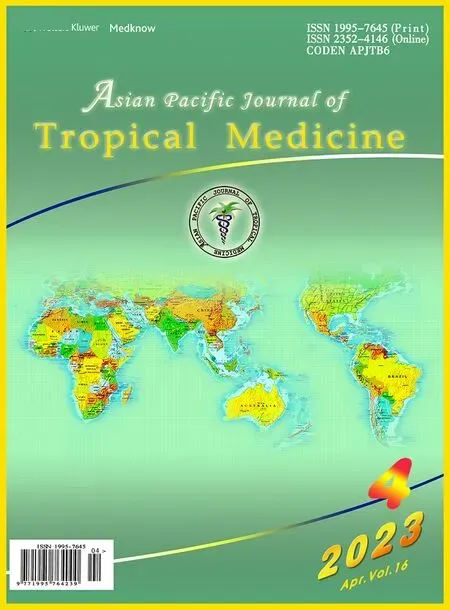Medicinal and biological potential of Thuja occidentalis: A comprehensive review
2023-05-15ManishThakurRanbirSobtiTejinderKaur
Manish Thakur, Ranbir Sobti, Tejinder Kaur
1Department of Microbiology, DAV University, Jalandhar, Punjab, India
2Department of Biotechnology, Panjab University, Chandigarh, India
3Department of Zoology, DAV University, Jalandhar, Punjab, India
ABSTRACT There is considerable evidence from a wide range of sources,including written texts, preserved monuments, and natural plant medicines, that demonstrate the long history of humankind's search for medicinal substances in the natural world.The purpose of this article was to compare the performance of medicinal plant Thuja(T.) occidentalis in a variety of disease-relieving conditions.The current review draws on the work of nearly two hundred original research papers indexed in Google Scholar, ScienceDirect, and the NCBI Library.The authors gatherd all the accessible data on the therapeutic effects of T.occidentalis.Although there are no published randomized controlled trials of T.occidentalis alone so far, multiple clinical investigations have validated the therapeutic efficacy of a combination herbal medication including the extract of T.occidentalis and additional immune stimulants.T.occidentalis is a plant with great potential as it is widely used in both traditional homoeopathy and modern, evidence-based phytotherapy.In vitro and in vivo models have shown its immunopharmacological potential, including its immunostimulatory, anti-cancer, anti-bacterial, anti-fungal, and antiviral activities.More researches into these plants might be done to find out if any of them have the potential to be implemented as a novel drug to treat a wide range of conditions.
Keywords: Herbal; Therapeutic; Thuja occidentalis
1.Introduction
Thuja trees are members of the order Pineales and the Cupressaceae family[1].Thuja (T.) occidentalis, tree species that is native to eastern North America and is now planted as an ornamental tree in a variety of locations, including India, Brazil, Europe, among others[2].Arbor vitae and white cedar are two more names for the same plant that are often used[3].In the sixteenth century, native Indians in Canada recognized this plant as a medicine for the first time and also found it effective in the treatment of scurvy-induced weakness[4].
2.Medicinal potential of T.occidentalis
Evidence-based naturopathy for acute and chronic upper respiratory tract infections includes the use of T.occidentalis in combination with other immunomodulating herbs[5].In traditional medicine, T.occidentalis has been used to treat a variety of conditions, including cystitis, rheumatism, amenorrhea, filiform warts, psoriasis, liver disease, bronchitis, uterine cancer, and diarrhoea among others[6-8].It has also been used as hair growth enhancing agent[9].The plant has also been reported to be anti-inflammatory in some recent studies[10,11].Some scientists have also reported the insecticidal and vermicidal potential of T.occidentalis[12-14].Essential leaf oil prepared from Thuja has been used to treat a variety of conditions,including cancer and intestinal worms and fungal infections[15,16].T.occidentalis has also been found to be effective against Saccharomyces cerevisiae, Macrophomina, Fusarium solani, Aspergillus niger,Aspergillus flavus, Aspergillus parasitious and, Trichophyton rubrum,among others[17-19].The secondary metabolites of plant have also shown substantial antimicrobial properties[20-24].It also contains antiviral chemicals that have a high in vitro therapeutic activity against herpes simplex virus, many of whose results are either old or published in German[25].The antiviral action of T.occidentalis has also been reported against Verruca vulgaris, HIV-1 and influenza A virus[26-28].T.occidentalis has also been found to a potential source of antioxidants[28-30].The ethanolic fraction of Thuja are antidiabetic and is found effective in the treatment of diabetic nephropathy[31,32].The plant has also shown anti-atherosclerotic activity in a previous study[33].The essential oil from the plant has also shown therapeutic potential against Polycystic Ovary Syndrome.It was found to exhibit an emmenagogue action against blocked menses, and is effective in the treatment of gynaecological illnesses because it alleviates the stomach discomfort, cramps, nausea, and exhaustion that are associated with menstrual cycles.By supporting hormonal balance via the release of specific hormones, such as estrogen and progesterone, it also aids in the regulation of the menstrual cycle and the maintenance of the health of the female reproductive organs[34].It also stimulates blood circulation and the release of hormones,enzymes, gastric juices, acids, and bile, it is also known to promote peristaltic action, as well as stimulation of nerves, heart, and brain,among other features[35].T.occidentalis in combination with other herbs is immunomodulatory[36-38].The medicinal properties of T.occidentalis are presented in Table 1.Due to widespread overuse of antibiotics, microorganisms have developed an unprecedented level of resistance to antibiotics.This marks the beginning of the “postantibiotic period”, during which some bacterial infections may no longer be treated, as they were in the past[39].T.occidentalis may provide a ray of hope in such a scenario.
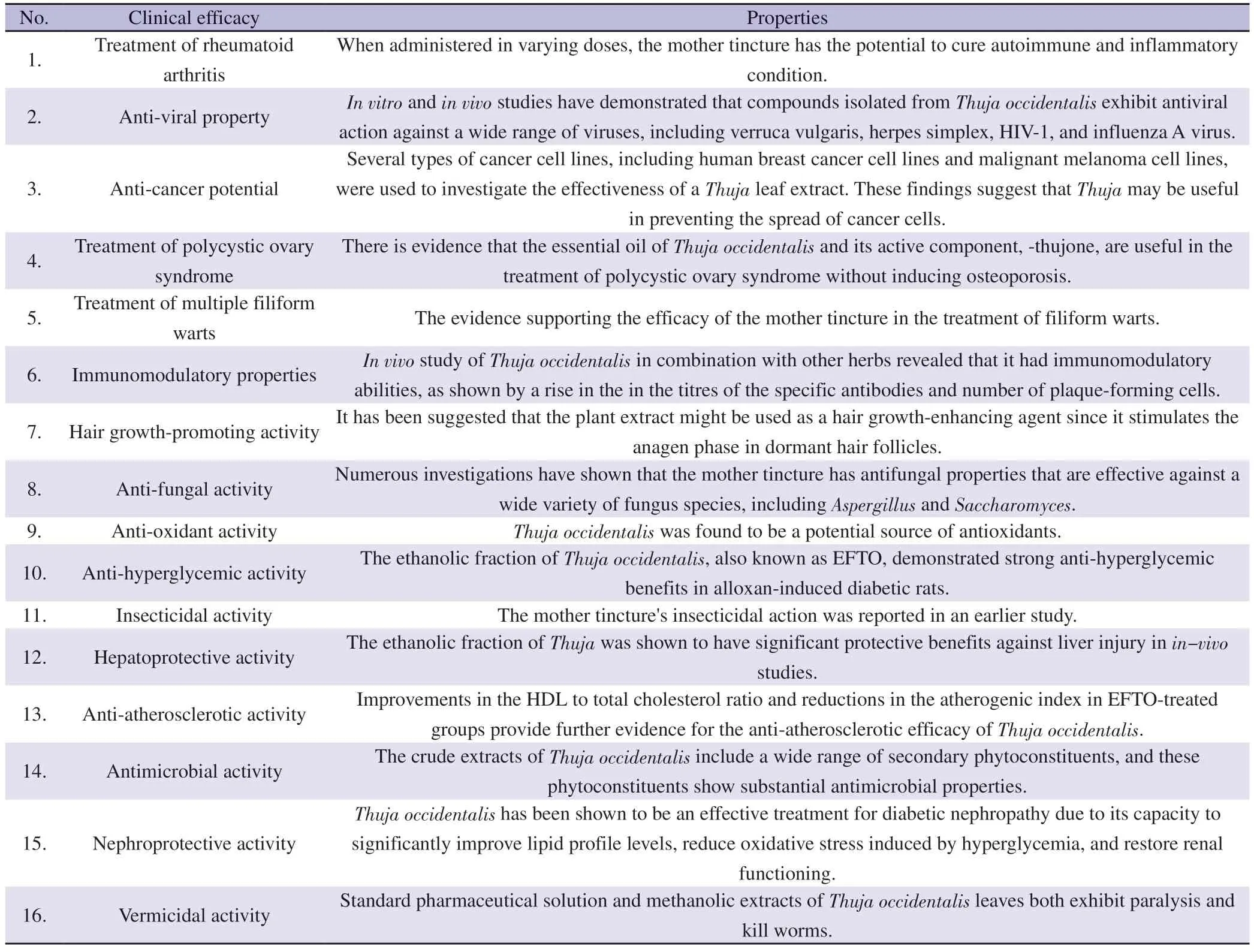
Table 1.Medicinal properties of Thuja occidentalis.
3.Biosynthesis of Thujone and its properties
Terpenoids, steroids, flavonoids, and polysaccharides are the compounds that have been found in T.occidentalis according to previous phytochemical reports[40].The major constituents of the plant are shown in the Figure 1.Thujone is reported to be the bioactive principle behind T.occidentalis.It is a monoterpene with two epimeric forms: (-)-α-thujone and (+)-β-thujone[41].Thujone’s IUPAC name is (4-methyl-1-(propane-2-yl) bicyclo [3.1.0]hexan-3-one (1S, 4R, 5R).The initial stage in the biosynthesis of thujone, as with other monoterpenes, is the formation of geranyl diphosphate also known as geranyl pyrophosphate (GPP) from dimethylallyl pyrophosphate and isopentenyl diphosphate, which is mediated by the enzyme geranyl diphosphate synthase.The first monoterpene, sabinene, is synthesized from GPP by the enzyme sabinene-synthase.The following step in the metabolic process involves changing sabinene into either trans (T.plicata) or cissabinol (Salvia officinalis).Thujones are synthesized via a NADPHdependent stereoselective reduction of sabinone[42].The pathway for biosynthesis of thujone is summarized in Figure 2.
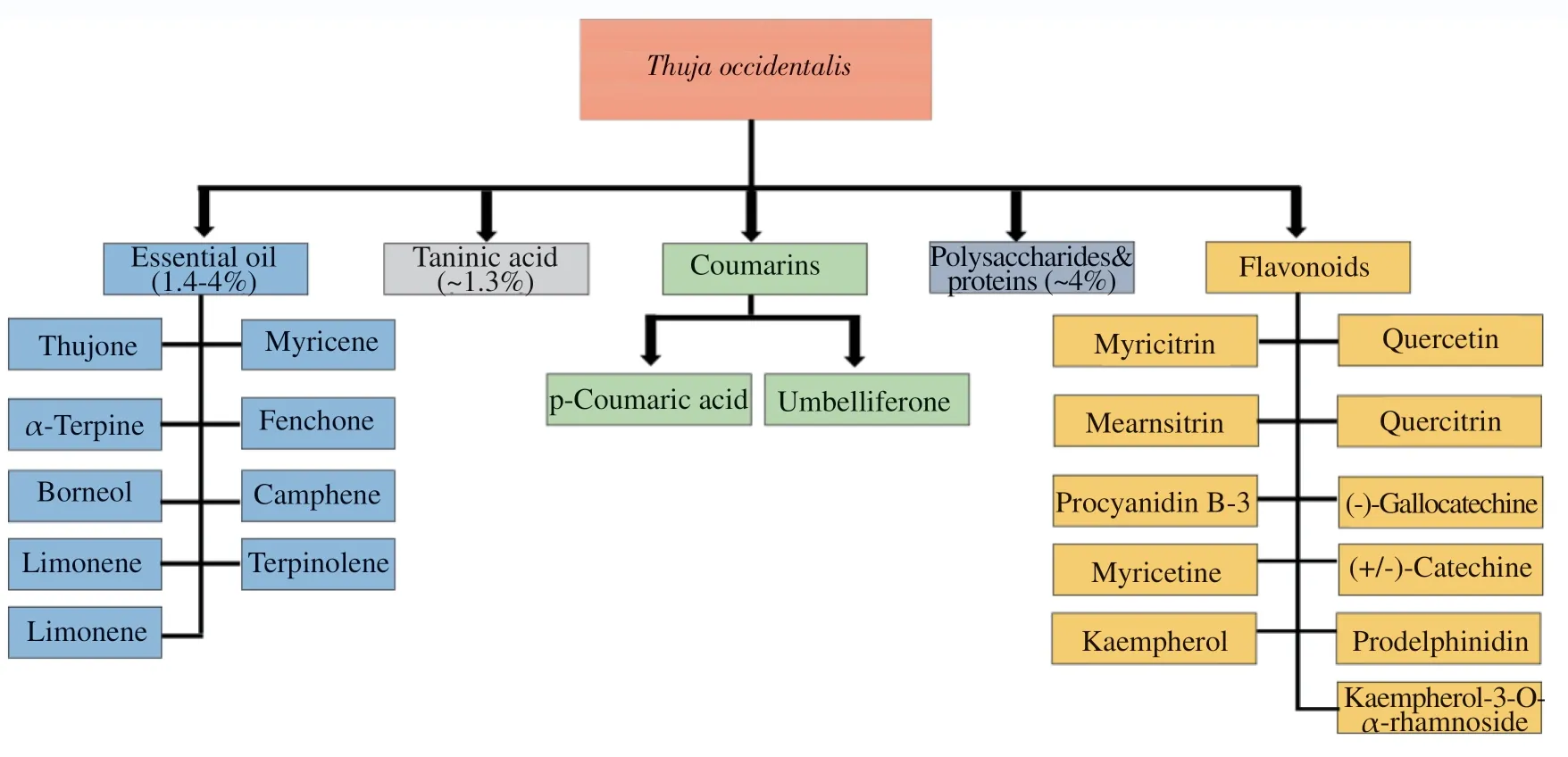
Figure 1.Compounds present in Thuja occidentalis.
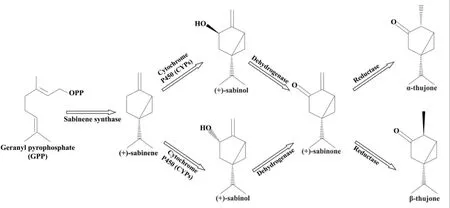
Figure 2.Biosynthesis of thujone from geranyl diphosphate also known as geranyl pyrophosphate (GPP).The first monoterpene, sabinene, is synthesized from GPP by the enzyme sabinene-synthase (SS).The following step in the metabolic process involves changing sabinene into either trans or cis-sabinol.Thujones are synthesized via a NADPH-dependent stereoselective reduction of sabinone[42].
In addition to T.occidentalis, thujone may be found in a wide range of plant species, such as Artemisia artemisia, Salvia officinalis, Salvia sclarea, Tanacetum vulgare, among others[43].Its antimicrobial effect is thought to be due to the high concentration of α- and β-thujone[44,45].It has been shown that thujone is highly effective as a mosquito repellent, antifeedant, and pesticide against both mammalian and insect herbivores[46-48].Plants high in thujone have a long history of usage in traditional medicine for the treatment of a wide range of conditions, including bronchial catarrh,enuresis, cystitis, psoriasis, uterine carcinomas, amenorrhea, and rheumatism[48].Thujone is also recommended for various types of cancers like skin tumorogenicity, ovarian cancers, adenocarcinomas,and glioblastomas[42,49,50].The anticancerous effect of thujone is because of ER stress leading to the ectopic ER expression of ATF6 phosphorylation.This increases proapoptotic unfolded protein response targets including CHOP, which leads to cell death.The unfolded protein response pathway between the endoplasmic reticulum (ER) and mitochondria causes intrinsic apoptosis.This pathway involves anti- and pro-apoptotic molecules like Mcl-1 and Bcl-2.ER stress, proteasome-linked protein degradation, and mitochondrial dysfunction induce apoptosis through these pathways,making them interesting targets for anticancer treatments[50].Figure 3 summarizes the anticancerous mechanism of action of thujone.

Figure 3.Mechanism of action of thujone in cancer cells.The anticancerous effect of thujone is because of endoplasmic reticulum stress leading to the ectopic endoplasmic reticulum expression of ATF6 phosphorylation.This increases proapoptotic unfolded protein response targets including CHOP, which leads to cell death.The unfolded protein response pathway between the endoplasmic reticulum and mitochondria causes intrinsic apoptosis.This pathway involves anti- and pro-apoptotic molecules like Mcl-1 and Bcl-2.ER stress, proteasome-linked protein degradation, and mitochondrial dysfunction induce apoptosis through these pathways, making them interesting targets for anticancer treatments[50].
4.Therapeutic potential of T.occidentalis
The plant has been researched by various coworkers for its therapeutic potential.The different therapeutic properties of the plant are summarized in Figure 4.The following subsections discuss the therapeutic properties of T.occidentalis in detail.
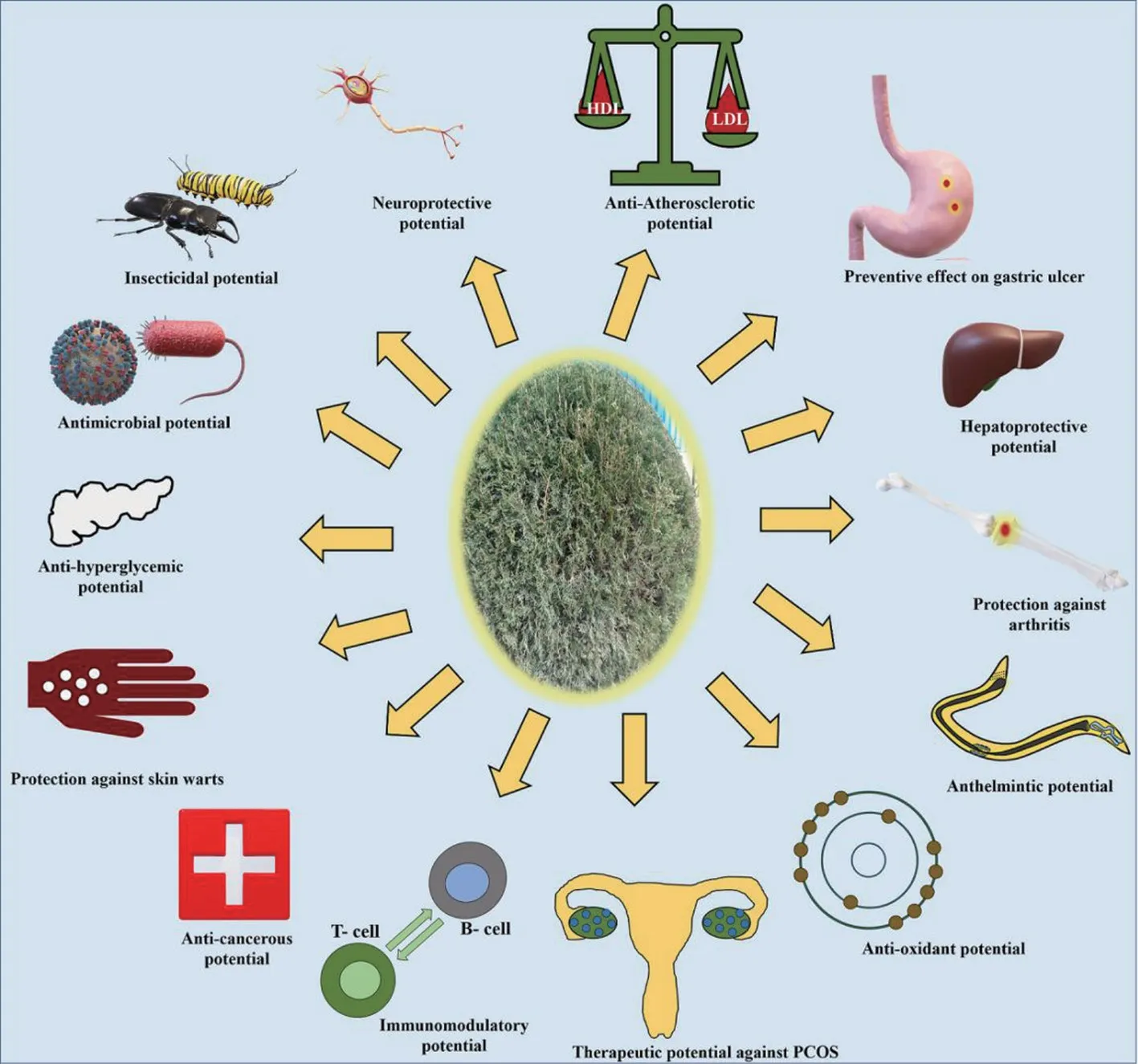
Figure 4.Different medicinal properties of Thuja occidentalis.
4.1.Antibacterial properties
T.occidentalis extracts and isolated substances have shown antibacterial activities against a substantial number of bacterial species, as outlined in the Table 2.Previously, Bakht and colleagues evaluated and validated T.occidentalis antibacterial effectiveness against Gram-positive bacteria (Bacillus subtilis and Staphylococcus aureus) and Gram-negative bacteria (Xanthomonas sp., Escherichiacoli and Klebsiella pneumoniae).T.occidentalis extract was shown to be particularly effective against Klebsiella pneumoniae, a Gramnegative bacterium[20].The Seo et al., 2017 study likewise validated these findings.Both Staphylococcus aureus and Escherichia coli were susceptible to the antibacterial effects of the essential oil that was isolated from T.occidentalis[21].Elansary and his colleagues made the discovery that the antibacterial activity of essential oil produced from T.occidentalis has a higher zone of inhibition than pharmaceuticals such as streptomycin and ampicillin[51].It has also been shown that the essential oil of T.occidentalis was found to be efficient against the two bacteria that cause the greatest damage to plants, Agrobacterium tumefaciens and Erwinia carotovora var.carotovora, respectively[70].It has been revealed that the hot water extracts of this plant had antibacterial activity against S.aureus and Escherichia coli[68] and the study conducted by Sah and co-workers agreed the findings against the same test bacteria[52].Eltayeb and Hamid discovered that extracts of the plant are more efficient against Gram-positive bacteria than Gram-negative bacteria, and that active components in the extracts are more potent against skininfected isolated bacteria.Also, the polarity of the solvent has a role in determining the level of antimicrobial activity[73].The high concentration of α (alpha) and β (beta)-thujone in the plant is thought to be responsible for the plant’s antibacterial characteristics,since these compounds have also shown considerable antibacterial activity against microorganisms and are often employed in essential oils that possess antimicrobial properties[22].
4.2.Anti-fungal properties
The antimycotic qualities of T.occidentalis have been mentioned in Table 3.
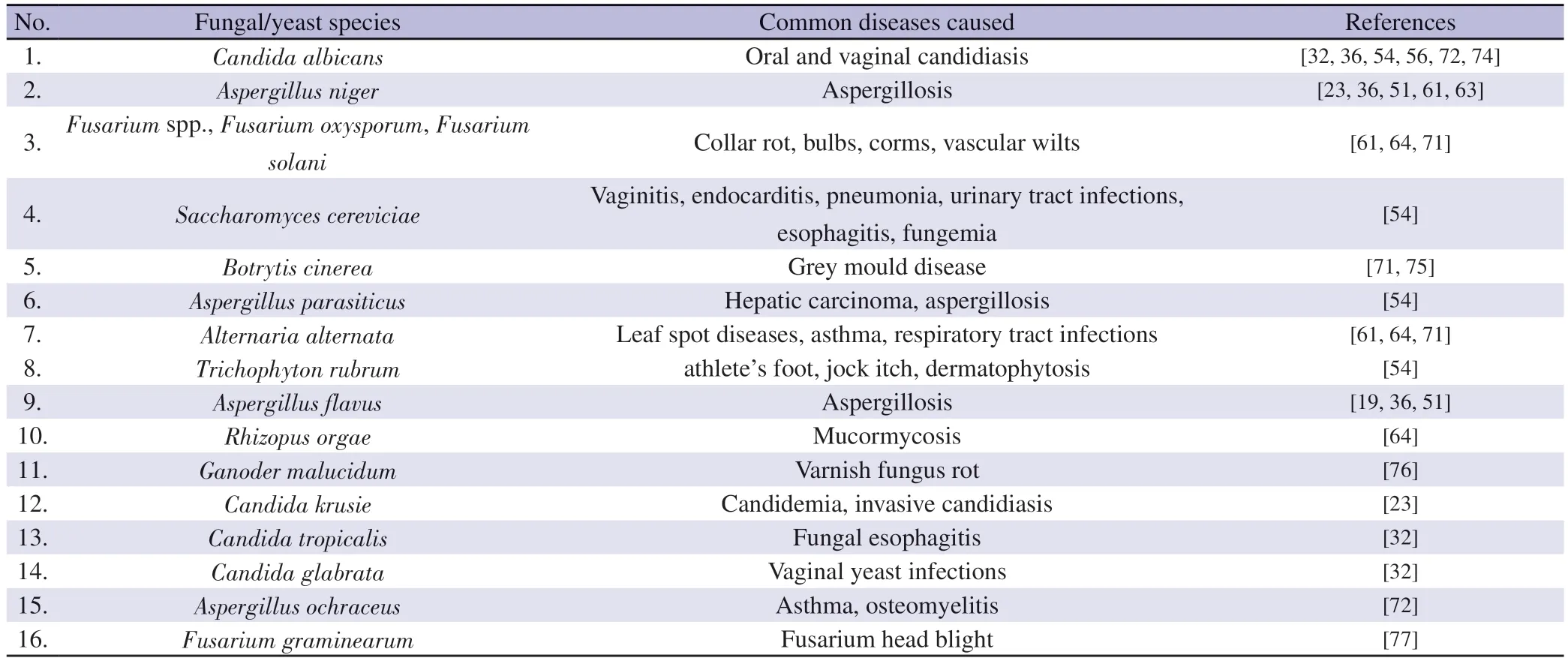
Table 3.Antifungal activity of Thuja occidentalis against different fungal species.
In addition to posing health risks to people and animals, fungi may also reduce crop production in the agricultural sector by harming plants.Many researchers are racing to identify various plants with the potential to serve as antimycotic medications, since these treatments are necessary for the treatment of fungal diseases.In early 2000s, Gupta and Srivastava evaluated the antifungal activity against Aspergillus flavus and Aspergillus niger and confirmed the efficacy of T.occidentalis[17].Considering that Aspergillus flavus is responsible for cutaneous aspergillosis and that Aspergillus niger is responsible for otomycosis, it is evident two fungi pose a significant threat to human health.The conclusions of the research study that was carried out by Bellili and his fellow researchers were validated by the essential oil that was derived from the leaves and cones of T.occidentalis.This essential oil showed antibacterial action against yeast (Candida albicans) and two types of fungi (Aspergillus flavus and Aspergillus niger), further they also determined the antibacterial activity against different Gram-positive and Gramnegative bacteria[56].T.occidentalis has been found effective against different fungal strains like Yersinia aldovae, Aspergillus parasiticus,Saccharomyces cereviciae, Trichophyton rubrum, and Candida albicans[57].The study conducted by Chinche et al., 2018 confirmed the promising results of T.occidentalis against Ashbya gossypii to treat stigmatomycosis diseases in cotton plants[18].
4.3.Anti-oxidant properties
In terms of the free radicals produced by cell metabolism,phenolic substances are best characterized by their antioxidant activity[72].In the 2014 research done by Kumar and colleagues,the radical-scavenging activity of Thuja extracts was compared to that of peach extracts.The research found that Thuja extracts had more reducing power than peach extracts, that is, (3.32±0.01) and(0.49±0.01), at OD700, respectively[29].The same findings were validated by Nazir and colleagues, who found that the methanolic extract of T.occidentalis had a stronger antioxidant capacity than other plant extracts[30].In another study, Ahmad, and colleagues,determined the DPPH scavenging activity of T.occidentalis at different concentrations that were found to be different, at 1 mg/mL, 5 mg/mL, 10 mg/mL, 50 mg/mL, 100 mg/mL they showed significant reductions 92.45%, 73.41%, 46.99%, 62.43%, and 61.57%, respectively[12].Stan and co-workers confirmed the antioxidant potential of the Thuja extracts using different techniques to measure the mother tincture's antioxidant capacity; 2,2-diphenyl-1-picrylhydrazyl free radical scavenging activity (DPPH), oxygen radical absorbance capacity assay, and nitric oxide radical scavenging assay (NO).The DPPH scavenging activity of T.occidentalis was 88.1%, oxygen radical absorbance capacity assay was 50.0%, and NO was 78%, respectively[78].DPPH activity was also measured and compared to the reference medication by Dubey and Batra in 2009.At a concentration of 300 μg/mL, Thuja extracts showed (73.346%±1.040%) DPPH scavenging activity with 202.457 μg/mL IC50value[8].
4.4.Anti-viral properties
According to the findings of Beuscher and Kopanski, T.occidentalis contains compounds that show antiviral action against the herpes simplex virus.This suggests that it may have therapeutic efficacy against this virus when tested in vitro[25].It has been shown that the polysaccharides that are derived from T.occidentalis have an antiviral impact as well as an immune boosting effect, having the potential to suppress HIV-1 and influenza A[79].An aqueous-ethanolic extract of T.occidentalis herbal, in combination with other extracts;Baptisiae tinctoriae radix, Echinacea purpureae radix, and Echinacea pallidae radix was tested on mice.The results showed, the extract significantly enhances the titer of specific antibodies in the serum of treated animals (sheep) and causes an increase in the number of splenic plaque-forming cells (PFC)[36].The findings of Gohla and co-workers showed that at a final concentration of 625 g/mL, Thuja polysaccharides (TPS), which are derived from the T.occidentalis tree, suppress the human immunodeficiency virus-dependent cell death which causes acquired immune deficiency syndrome[26].An infection with Verruca vulgaris induced by the human papillomavirus increases the likelihood of developing squamous cell cancer.The many therapeutic techniques that are available only provide a limited response.A case of a recipient of a renal allograft with several warts that did not respond to cryotherapy or radiosurgery.Eventually,one of the warts turned malignant and necessitated the amputation of a finger.The resistant warts on the other fingers were healed using an extract from the T.occidentalis.The extract only caused superficial scarring to appear[27].T.occidentalis has several useful immunological qualities that may also be used to the treatment of respiratory viral infections[80].
4.5.Anti-cancerous properties
T.occidentalis has been used for a very long time by practitioners of traditional medicine as a mother tincture for the treatment of a broad number of ailments, including moles and tumors, in addition to a wide variety of skin and other illnesses.The anti-proliferative and apoptosis-inducing capabilities of the Thuja plant and the thujone-rich fraction isolated from it were investigated by Biswas and colleagues for their potential anti-cancer effects in a malignant melanoma cell line.The results indicate that both the Thuja plant and the thujone-rich fraction has anticancer potential.In addition, when comparing their anticancer potential, the thujone-rich fraction of T.occidentalis showed much more cytotoxic, anti-proliferative, and apoptotic activities on A375 cells in vitro[15].
According to research that was conducted in 2010 by Frenkel and colleagues, it seems that homoeopathic medications, when taken in extremely low dosages, have selective cytotoxic effects on the human breast cancer cell lines MCF-7 and MDA-MB-231.Alterations in the expression of cell cycle regulatory proteins have been shown to be associated to both the delay and stoppage of the cell cycle as well as the promotion of cell death via the activation of the apoptotic cascade[81].T.occidentalis, as discovered by Sunila and coworkers in the year 2011, may inhibit the production of excessive amounts of inflammatory cytokines[82].
In the report from the year 2020, Jean-Lionel states that mice administered T.occidentalis lived longer than placebo-treated mice and that an alcoholic extract of the plant was helpful in blocking the spread of melanoma cells to the lungs[83].The extract of T.occidentalis demonstrated exceptional apoptotic capacity against lung cancer cells and the ability to ameliorate BaP-induced lung damage[84].
The recently published research by Loonat and colleagues in 2022 demonstrates that A549 cells were treated with T.occidentalis and with combination therapy using photodynamic treatment before being subjected to 660 nm laser irradiation.An examination of cellular morphology was performed using inverted light microscopy and Hoechst staining.The cells were subjected to biochemical testing, including the lactate dehydrogenase assay, the adenosine triphosphate assay, and the trypan blue exclusion test.Antitumor responses of T.occidentalis were amplified with photoactivation in photodynamic therapy.These effects made it possible to provide advantages beyond those of tincture treatment alone[85].
There are several different cancer cell lines that have been tested with the extract derived from Thuja leaves, and the results have been encouraging[16,86].Singh and coworkers showed the cytotoxic effect of T.occidentalis on cervical cancer cells in vitro.Similar effect was observed by Pal et al.by using T.occidentalis homeopathic mother tincture[87,88].
4.6.Immunomodulatory activities
T.occidentalis has been reported to increase WBC count in the treated swiss mice infected with bacteria.This confirms the immunomodulatory potential of the plant[55].Bodinet and Freudenstein examined the immunological responses of mice to an aqueous-ethanolic extract of the T.occidentalis herb and other plant extracts.The number of antibody-producing cells in the spleen and the hemagglutination titers both rose after receiving a dosage of 4 mg/kg of body weight[36].In addition, the author observed an increase in the proliferation rates of spleen cells isolated from both NMRI and C3H/He J mice[37].The polysaccharide fractions that were extracted from the T.occidentalis were shown to activate CD4+T cells[38].Spleen cells that were extracted from mice that had been treated with T.occidentalis generated increased levels of immunostimulatory cytokines ex vivo.These cytokines were IL-2 and IFN-γ.Immune response to tumor-bearing mice might be improved by T.occidentalis and TPS activation of NK cells and antibody-dependent cellular immunological responses.Perhaps, it might reduce the increased amount of pro-inflammatory cytokines in B16F-10 melanoma cells.Increased IL-2 levels can boost natural immunity by activating NK cells.In addition, the therapy with these drugs boosted the amount of the endogenous tumor inhibitor TIMP.These findings demonstrated the immune-stimulating action of T.occidentalis and TPS in rats with metastatic tumors.It has been demonstrated that the T.occidentalis polysaccharide fraction, also known as TPS, is an inducer of the CD4+fraction of the human peripheral blood T-cell subset[89].Researchers have discovered that the CD4+fraction of the T-cell subset in human peripheral blood may be stimulated by a compound found in Thuja called thuja polysaccharide fraction (TPSg).FACS analysis also characterized the TPS g fraction stimulated CD4+T-cell fraction.TPSg increases the production of IL-1 beta, IL-2, IL-3, IL-6, gamma-IFN, G-CSF,GM-CSF, and TNF-beta in monocyte/macrophage cells and PBL cultures.The capacity of TPS to stimulate cell proliferation and clustering leads in an increase in CD4+T-helper/inducer cells and the subsequent production of interleukin-2 (IL-2).T-helper cells proliferate and develop into fully functional cells via the processes of proliferation and differentiation[90].
4.7.Preventive effect on gastric ulcer
The observations of an alcohol-induced stomach ulceration model indicate that treatment with an extract of the aerial portion of T.occidentalis resulted in a substantial reduction in the ulcer index.In alcohol-induced stomach ulcers, a reduction in mucosal resistance is the most relevant etiology factor when compared with a positive control.However, there is evidence to suggest that alcohol stimulates the production of protein into gastric juice.The amount of glutathione in the stomach mucosa is decreased when an ulcer is induced by ethanol usage[91].T.occidentalis ethanol extract has been shown to significantly prevent stomach ulcers in rats caused by both ethanol and aspirin, according to research published in 2009 by Deb et al.The amount of stomach acid was observed to be reduced by 45% (P<0.05) and 69% (P<0.001) in the two doses of 200 and 400 mg/kg of T.occidentalis methanolic extract, respectively, in previous research.Gastric epithelial regeneration was most evident in rats given 400 mg/kg.T.occidentalis has been shown to have antioxidant properties, and this research confirms that these properties contribute to the fruit's antiulcer effect[92].
4.8.Protection against arthritis
To determine whether T.occidentalis possesses anti-arthritic capabilities, Patil and coworkers conducted an experiment on Wistar rats.As part of their research, they compared the effects of pure T.occidentalis to those of various dilutions of the homoeopathic treatment.Based on their findings, the researchers concluded that T.occidentalis is effective against arthritis.In addition, they concluded that a 6cH homoeopathic dilution of the medicinal plant was more efficacious than the undiluted version of the same plant[6].Dr.Jenifer Antoni observed the same findings and reported them when she was treating a patient who appeared with a range of symptoms, including discomfort in the knees and numbness in the neck region.The patient was prescribed rhus tox 1M and Thuja as a remedy, which led to a gradual improvement in the patient’s symptoms as well general state of health[7].
4.9.Protection against skin warts
A recently published case study revealed that T.occidentalis could be a useful therapy for many filiform warts.Within 41 weeks of treatment, a patient with numerous facial warts of diverse diameters(ranging from 1 mm to 10 mm) was successfully treated with T.occidentalis in a variety of different potencies and the patient's condition improved significantly[93].In fact, the Thuja homeopathic ointments and oils are readily available in market for the treatment of skin warts.
4.10.Therapeutic potential against polycystic ovary syndrome
Küpeli-Akkol and coworkers investigated the potential benefits of T.occidentalis and its constituents for the treatment of polycystic ovary syndrome.Results indicated that estradiol and progesterone levels increased substantially, whereas luteinizing hormone and testosterone levels decreased significantly.T.occidentalis and its component thujone groups also had significantly reduced plasma concentrations of low-density lipoprotein-cholesterol, leptin, and glucose compared to the values seen in the control group[34].
4.11.Hepatoprotective activity
Earlier research revealed that the ethanolic fraction of T.occidentalis might have a hepatoprotective benefit against CCL4-induced liver damage in rats.According to the findings of the research conducted,the ethanolic fraction had a beneficial impact.In a model of CCL4-induced liver damage that was either acute or chronic, a single injection of T.occidentalis at a dosage of 400 mg/kg, demonstrated significant protective benefits against liver damage.This effect was seen in both models.Following the completion of the treatment, a histological examination was carried out in order to assess the level of hepatoprotection that had been attained[94].In another study,increased levels of SGPT and alkaline phosphatase in the liver and serum in gamma irradiated mice were lowered by T.occidentalis ethanol extract[95].
4.12.Anti-hyperglycemic activity
An ethanolic fraction of T.occidentalis (EFTO) was administered to wistar albino rats in research by Dubey and Batra in 2008 to investigate its possible anti-diabetic effects.The prevalence of diabetes in alloxan-induced cases was studied by measuring fasting blood sugar, blood glutathione levels, and serum biochemical analyses.A dosage of 200 mg/kg of the extract was demonstrated to have a significant impact on diabetes.Due to EFTO’s anti-oxidant effect, glutathione levels also rose significantly[31].According to Tyagi et al., T.occidentalis has the potential to ameliorate renal and liver function and enhance glucose homeostasis in alloxan-induced diabetes.Therefore, the novel oral antidiabetic medication may originate in the branches of the T.occidentalis tree[96].
4.13.Anti-atherosclerotic property
An investigation of the lipid peroxidation activity and associated hypolipidemic activity of an ethanolic extract of T.occidentalis was carried out on rats by Dubey and colleagues.The extract's hypolipidemic effect significantly decreased blood levels of cholesterol, LDL, and triglycerides when administered at doses of 200 mg and 400 mg/kg of body weight, respectively.Strong evidence suggests that T.occidentalis has an anti-atherosclerotic effect, as shown by an improvement in the ratio of HDL to total cholesterol and a decrease in the atherogenic index in groups that were given EFTO[33,97].
4.14.Neuroprotective efficacy
In recent study, Bhargava and coworkers induced diabetic neuropathy in male Wistar rats using streptozotocin and nicotinamide to test the neuroprotective effects of T.occidentalis using a single dose of streptozotocin (65 mg/kg).Different doses of gabapentin and T.occidentalis hydroalcoholic extracts were administered to Wistar rats for a month.Specifically, the results demonstrated that T.occidentalis is an effective treatment for diabetic neuropathy because it increases neuronal activity while reducing hyperglycemic-induced oxidative stress and inflammatory indicators[32].
4.15.Insecticidal activity
Insects have become resistant to synthetic pesticides, which has led to an increase in environmental concerns, which in turn has led to a rise in interest in the use of medicinal herbs as insecticides during the last decade[98].An investigation of the effectiveness of T.occidentalis as an insecticide, carried out by Ahmad and his fellow researchers on T.castaneum.Permethrin was employed as a reference standard for determining the insecticidal action, and at 100 mg/2 mL, the percentage mortality was determined to be 100%.The mortality rates of 20%, 20%, and 40% were recorded, respectively, after being exposed to 10 mg/2 mL, 50 mg/2 mL, and 100 mg/2 mL of T.occidentalis[12].The essential oil of T.occidentalis has been reported to have comparable biological effects on stored grain insects similar to the tropical oils such as Ocimum oils[99].
4.16.Anthelmintic activity
The anthelmintic activity of T.occidentalis was evaluated by Dasari and co-workers in 2021, using the adult Indian earthworm species Pheretima posthuma, which has morphological and physiological characteristics with intestinal roundworms.The dosages tested were 10, 20, and 50 mg/mL.The highest dosage tested, which was 50 mg/mL, showed a significant anthelmintic action when compared to the standard reference, which was piperazine citrate at 10, 20, and 50 mg/mL.In treating helminthic infestations, it was shown that herbal remedies and synthetic pharmaceuticals were equally beneficial.However, the methanolic extract of T.occidentalis showed the greatest promise and had the highest anthelmintic activity[14].Boyko and Brygadyrenko reported the anthelminthic activity of aqueous solution of T.occidentalis against Strongyloides papillosus[100].
4.17.Antipyretic activity
T.occidentalis methanol extract was shown to be effective as an antipyretic in rabbits.When administered at 100 and 200 mg/kg of body weight, it has the same antipyretic and temperature-regulating effects as paracetamol[101].T.occidentalis, Linn was tested for antipyretic efficacy against TAB (Typhoid) vaccination and PGE1-induced rabbit pyrexia.In TAB vaccine-induced fever, oral 100 and 200 mg/kg doses decreased fever and stabilized body temperature,equivalent to the reference medication (Paracetamol).Unlike the conventional medicine, PGE1 decreased pyrexia (Aspirin).
4.18.Radioprotective activity
Researchers found that T.occidentalis provides protection against radiation by increasing TNF-α, IL-6, and IL-1 activities[1].Sunila and Kuttan found that T.occidentalis reduced gamma-induced toxicity in Swiss albino mice.Therefore, alkaline phosphatase,pyruvate transferase, and lipid peroxidation were all lowered by the T.occidentalis alcoholic extract[96].
4.19.Antileishmanial efficacy
Not much work has been done on the antiprotozoal potential of T.occidentalis.However, in a study, Rani and Dantu reported moderate antileishmanial efficacy of T.occidentalis[102].
4.20.Treatment of tongue lesions
A recent study done by Dr.Bed Prakash Gond reported the effectiveness of T.occidentalis in the treatment of Mucocele or the nodular lesions of the tongue.The treatment was given to a 4 year female child whose Mucocele of the tongue was resolved within a month after treatment with low potency (30CH) of T.occidentalis[103].
5.Conclusions
Many medicinal plants have had their healing powers recognized,recorded, and passed down through history since the emergence of humans and advanced civilizations.Until now, successive civilizations have continuously enhanced pre-existing infrastructure and developed new sources of wealth.It is because of this commitment that we now have a highly refined method for caring for and using therapeutic plants.T.occidentalis could be possible the future super-plant as it is widely used in both traditional homoeopathy and modern, evidence-based phytotherapy.In vitro and in vivo models have shown its immunopharmacological potential, including its immunostimulatory, anti-cancer, antibacterial, anti-fungal, and antiviral activities.Despite these encouraging results, more definitive evidence from clinical studies is needed, notably with only the herbal compound.
6.Limitations
T.occidentalis is a plant with wide medicinal potential but it has certain limitations.Thujone, the bioactive principle behind the plant has certain side effects.It is hallucinogenic and may cause epileptic seizures.It can cause stomach aches and can lead to renal failure also[104-109].However, these effects may be ameliorated by nanoencapsulation, charcoal treatment, or UV irradiation.
7.Future perspectives
There are approximately 500 000 different plant species all over the world, the vast majority of which have not yet been investigated in the context of medical practices.As a result of this, there is reason to be optimistic regarding the potential of therapeutic herbs.Research in medicine that is now being done as well as research that has not yet been done can be helpful in the diagnosis, treatment,and prevention of illnesses.In healthcare systems all around the world, T.occidentalis is used as a source of adjuvant treatment,which is used not only to treat diseases but also to prevent diseases and to keep people healthy.Despite the rich history of traditional medicinal use of T.occidentalis, modern scientific investigation and identification of active plant components and their effects indicate the potential for the development of novel therapeutic applications and the creation of nature-based products.In order to accomplish this goal, it is essential to conduct extensive research in order to control the quality and the formulation in order to justify their use in the modern medical system; subsequently, studies on animals and clinical trials are required in order to make use of the benefits offered by this plant.In addition, a workable strategy for the preservation of these resources ought to be created as part of the process of developing medicines derived from T.occidentalis.
Conflict of interest statement
The authors declare that there is no conflict of interest.
Funding
The authors received no extramural funding for the study.
Authors’ contributions
MT and TK wrote the manuscript.MT has created all the figures.TK and RCS has edited the manuscript.All the authors have contributed to the final version of the manuscript.
杂志排行
Asian Pacific Journal of Tropical Medicine的其它文章
- Preventive strategies to innovate Japanese encephalitis control in eastern Uttar Pradesh: Accelerating towards zero incidence
- Dengue positivity among blood donors in hyper-endemic region of southern India
- Myositis and rhabdomyolysis in scrub typhus infection: A case report
- COVID-19 vaccine uptake and its determinants among teenagers and their parents in Zhejiang, China: An online cross-sectional study
- Early efficacy of individual regimens containing bedaquiline in patients with drug resistant tuberculosis
- Acceptance, availability and feasibility of RTS, S/AS01 malaria vaccine: A review of literature
